
Guests
- Richard Ray Perezfilm director and producer. His most recent film, Cesar’s Last Fast, just premiered at the Sundance Film Festival. He also works as a producer in the documentary program at the Sundance Institute.
As farmworkers continue to fight for fair wages and safe working conditions across the United States, we look at the life of legendary organizer Cesar Chavez. In 1962, Chavez founded the National Farm Workers Association, which would later become the United Farm Workers of America. He led the union for the next three decades and organized a series of historic strikes and boycotts. The new documentary “Cesar’s Last Fast” features never-before-seen footage of Chavez’s 36-day fast in 1988 to raise awareness about the dangers of pesticides in the field. We are joined by the film’s director, Richard Ray Perez, whose father was a farmworker laboring in the conditions Chavez fought to improve.
Transcript
AMY GOODMAN: Yes, we’re broadcasting from the Sundance Film Festival in Park City, Utah. The Coalition of Immokalee Workers won a victory last week when Wal-Mart, the world’s largest retailer, signed onto an agreement to improve wages and working conditions for farmworkers in its supply chain. About 30,000 workers will directly benefit from Wal-Mart’s decision to join its Fair Food Program. Eleven other companies have joined the program, including Chipotle, McDonald’s and Whole Foods.
Well, today we turn to a new documentary focusing on the nation’s best-known farmworker organizer, Cesar Chavez. In 1962, he founded the National Farm Workers Association, which would later become the United Farm Workers of America. He led the union for the next three decades and organized a series of historic strikes and boycotts.
Here at the Sundance Film Festival, a new documentary has just premiered called Cesar’s Last Fast. The film features never-before-seen footage of Chavez’s 1988 36-day fast to bring attention to the dangers of pesticides in the fields. The film is directed by Richard Ray Perez and Lorena Parlee. This is an excerpt.
DR. FIDEL HUERTA: Today is day 30 of Cesar Chavez’s water fast. He’s lost approximately 30 pounds. His physical stamina is rapidly deteriorating. I believe I am—we are getting to a critical point of his fast here.
UNIDENTIFIED: We’re all of the opinion that we strongly urge Cesar to give serious consideration to discontinuing his fast.
PAUL CHAVEZ: He was in so much pain. Towards the end, he couldn’t talk very much. I remember people would come in to comfort him, right? He ended up comforting them, and they felt much better when they left, right? And so, not only did he have to carry the burden of his own fast, right, but he had to comfort folks that came to see him, as well.
AMY GOODMAN: That’s an excerpt from Cesar’s Last Fast. Director Richard Ray Perez joins us here in Park City. His father was a farmworker who labored and lived in the conditions Cesar Chavez fought to improve. When Perez was four years old, he and his family joined the grape boycott and marched in the picket lines that Cesar Chavez and the United Farm Workers of America organized to pressure growers to sign labor contracts that guaranteed the humane treatment of California’s grape pickers.
Richard Ray Perez, welcome to Democracy Now!
RICHARD RAY PEREZ: Thank you, Amy.
AMY GOODMAN: What a documentary.
RICHARD RAY PEREZ: Yeah, we’ve been getting a wonderful response here at Sundance, and it’s just such an honor to bring it to this platform and introduce and reintroduce Cesar’s story to a new generation of Americans and, ultimately, a new generation of global citizens.
AMY GOODMAN: So, tell us a story. Tell us the story of Cesar’s last fast.
RICHARD RAY PEREZ: Well, in 1988, Cesar was 61 years old at the time, and the United Farm workers had been struggling to regain the victories that they had in the '60s and the ’70s. And so, they launched a third grape boycott, because the laws that were set up by Jerry Brown in California to protect farmworkers and give them the right to collectively bargain weren't being enforced, and they were struggling to sort of stay successful.
At the same time, cancer clusters emerged in Central California in Central Valley. Farmworkers—farmworker women were reporting unexplained miscarriages. Their children were born—being born with severe deformities and a lot of cancer. There were very, very high cancer rates. All the evidence pointed to the use of pesticides, which at the time were loosely regulated.
So Cesar decided to go on a fast to recommit himself to this third grape boycott, and particularly around the unregulated use of pesticides in the fields and on farmworkers. So, he told nobody in the first few days. And after a few days, his wife really sort of figured out what was going on. And at that point, people started to slowly rally around him; primarily the UFW workers and a few very close supporters came to where he was fasting at Forty Acres, the UFW compound.
AMY GOODMAN: And then describe what happened over those 36 days.
RICHARD RAY PEREZ: Sure. So, at the time, his press secretary was a woman named Lorena Parlee, and she was very close to Cesar. She had been working with him for a number of years. And she began videotaping as much as she could all the activity around this fast. She had unprecedented access to and very intimate access to Cesar in his fasting chamber and the interactions he had with the UFW staffers, with family, with doctors. And what she captured was some raw material that showed a visible decline in his health every day as the fast progressed. So when I got the footage and started looking at it, it became very clear that there was a story around this fast where Cesar is getting weaker and weaker day by day.
The family is getting more concerned. They come in and try to talk him into breaking the fast, and it doesn’t work. Doctors come in a few days later and try to reason with him, and he doesn’t decide—he decides to keep fasting. And ultimately, Jesse Jackson, who had just finished a presidential campaign, came in at around day 34 and proposed to Cesar this plan that he and the other supporters around him—Dolores Huerta, Martin Sheen—would take on the fast, and they would fast for three days and pass it along. That way, Cesar’s fast can continue among his supporters, and Cesar could then eat again and hopefully spare his health.
AMY GOODMAN: And so, describe those last days and the footage that you have in this documentary.
RICHARD RAY PEREZ: Sure. Cesar is so weak that he is sort of slipping in and out of consciousness. There are moments when he looks like he very well could have passed away. And in those moments, you sort of realize how dedicated he is to this cause and essentially his willingness to die for the cause, but also the recklessness of it. Here is a man that was leading—that had led this historic movement, and you start to wonder: Could he have recklessly decided to give his life for this cause and at the same time sort of threaten the efficacy of his movement at that time because of what could be seen as recklessness?
But fortunately, he breaks his fast. And during—on day 36, he’s so weak, his sons have to carry him into a mass. There were 7,000 people who came to a mass where Cesar was to break his fast. They carry him in. They sit him next to his 96-year-old mother, who’s in tears, and—on one side; and on the other side is Ethel Kennedy, who has come to help him break the fast. Her husband, Robert Kennedy, was at Cesar’s side in 1968 when Cesar broke his first fast. And at the right moment during the mass, Cesar—or a priest brings a piece of bread to Ethel Kennedy. She breaks off a piece, gives Cesar his first food in 36 days, his mother cries, and the crowd goes wild. So it’s a heavily symbolic moment with breaking of the bread and as sort of a taking of the host, if you will, for this just incredible act of sacrifice.
AMY GOODMAN: Can you talk about the access that this film gives all of us, the access that—well, in a sense, you’re co-director of the film. She died in 2006.
RICHARD RAY PEREZ: Yes.
AMY GOODMAN: Why she had it?
RICHARD RAY PEREZ: Well, she had it—she, Lorena herself, was a filmmaker.
AMY GOODMAN: This is Lorena Parlee.
RICHARD RAY PEREZ: Lorena Parlee, yes, my co-director, was a—herself was a filmmaker. And she had volunteered for the UFW, became Cesar’s press secretary, in exchange for someday being allowed to make a film about Cesar. So, she had it in her mind that she had this—well, she saw the opportunity to record this historic footage. I think she saw it after it progressed, because she really started recording around day 23. And she recruited a cameraman named Jim Chressanthis, who we later connected with and shot a lot of our interviews with. So, this opportunity had never existed before. Cesar was a very, very private man, although he had a very public life. And it was phenomenal that in this sort of setting that she was, first, courageous enough to turn on the cameras and, at the same time, respectful enough not to sort of invade this, you know, intensely personal act. So, in that process, she captured this phenomenal footage that, when I started looking at it—I inherited the footage in 2007—I couldn’t believe my eyes. I thought, “Oh, my god, is this really what I think it is?”
AMY GOODMAN: And how did you get involved?
RICHARD RAY PEREZ: So, my—as was mentioned when you introduced the show, that my father had been a farmworker. And when I was a kid, my family were active in supporting the farmworker movement. So, years later, when I became a documentary filmmaker, I was interested in doing a documentary about Cesar Chavez. And so, at one point, my mentor and colleague, Robert Greenwald, talked about it, and we could never sort of work out our schedule, and it didn’t happen.
Then one day I got a call from a woman, who said, “Hi, I’m Lorena Parlee. I heard you’re interested in doing a documentary [film]. I’m already working on a project.” And I had heard that somebody is working on a project, and I was—at that point, I was thinking of just letting it go. So, she tells me that—you know, her history. She had been, you know, Cesar’s press secretary. She had been working on the project at that point for 10 years. She had amassed 85 hours of footage, including this footage that had never been seen before of the fast. She also had this very intimate footage of Cesar’s family’s private burial service and the rosary and Cesar lying in state and the grandchildren helping cover the coffin with dirt and Cesar’s brother building Cesar’s coffin. It was all an incredible trove of footage. And she said she had been struggling to finish the film and was looking for a collaborator, and she asked me if I was available to help her out as a producer. At that point I had produced a number of projects. And I said I would love to help her. “I would love to help you.” But I had just signed on to direct a series, and I wasn’t available for six months. So I said, “Lorena, in six months, you know, I’ll jump on the project. We’ll get it going.” And she said, “Well, I need somebody to help me now, because I’m being treated for breast cancer, and I could only work on the project for two weeks out of the month.” So, clearly, I was startled and moved. And during our conversation, there was a real sense of trust and just bonding. So I told Lorena, I said, “In six months, if you haven’t found somebody, just let me know. I’ll work on this project. You don’t need to pay me. I am really committed to this cause.”
Six months passes, and I didn’t hear from her. I assumed she found somebody else. Nine months later, I get a phone call from an elderly gentleman, and he says, “Hi, I’m Lorena Parlee’s stepfather. Lorena died last month of breast cancer, and she left your name in her notes for us to contact you to see if you would finish her film. Do you want to finish her film?” So at that point it became a tremendous responsibility, not only for my family’s history, but for Lorena’s legacy. Lorena had committed her life to this cause. She was a wonderful human being. I can tell by everything that she left behind. So I embarked on a mission to ensure the completion of this film.
AMY GOODMAN: And so, you tell the story, though, not only of this last fast of Cesar Chavez, but of Cesar Chavez through his life. I wanted to turn for a moment to Cesar Chavez in his own words, speaking at the Commonwealth Club in San Francisco in November of 1984, a few months after he had launched the third and longest grape boycott.
CESAR CHAVEZ: Today, thousands of farmworkers live under savage conditions, beneath trees and amid garbage and human excrement near tomato fields in San Diego County, tomato fields which use the most modern farm technology. Vicious rats gnaw at them as they sleep. They walk miles to buy food at inflated prices, and they carry in water from irrigation ditches.
Child labor is still common in many farm areas. As much as 30 percent of Northern California’s garlic harvesters are underaged children. Kids as young as six years old have voted in state-conducted union elections since they qualified as workers. Some 800,000 underaged children work with their families harvesting crops across America.
All my life, I have been driven by one dream, one goal, one vision: to overthrow a farm labor system in this nation that treats farmworkers as if they were not important human beings. Farmworkers are not agricultural implements. They are not beasts of burden to be used and discarded.
AMY GOODMAN: [inaudible] 1984. Our guest is Richard Ray Perez, who has just produced a documentary, Cesar’s Last Fast. So tell us—as Cesar Chavez says, “All my life, I have been driven by one dream, one goal, one vision,” tell us about Cesar Chavez and how he came to co-found the United Farm Workers.
RICHARD RAY PEREZ: Sure. In his formative years, when Cesar was a child, he was forced to work in the farm—in the fields of California after his family had lost their plot of land. So he knew from direct experience what it was like to live and work as a farmworker, as a migrant farmworker in the Depression era. He had these direct experiences that just were etched in his soul, and they were very painful experiences. Those experiences really fueled his work for his entire life. I think Cesar was an incredibly empathetic person. Those memories could not escape him. And at the same time, rather than being angry or being self-destructive, they fueled him to try to change something. He ultimately learned community organizing in urban areas, but that farmworker condition never left him. So he applied the community organizing skills to communities, in communities of—in the Central Valley to organize farmworkers.
AMY GOODMAN: And talk about what was unique about his organizing model.
RICHARD RAY PEREZ: Sure. Well, in some ways, there was—his organizing model was based on the organizing model of Saul Alinsky, which was passed on to Cesar’s mentor, Fred Ross, and Fred then trained not only Cesar, but Dolores Huerta. What was different about Cesar’s model, once he embraced it, he really brought in sort of the cultural components of it. And he sought to organize not only the workers, but their families. And his organizing often involved faith and prayer. The Filipinos farmworkers and the Mexican-American, Chicano and Mexican farmworkers were Catholics, primarily. And Cesar had a deep, deep faith that was passed along to him by his grandmother and his mother. And he used that faith to fuel the inspiration the farmworkers needed to keep going, to believe that they can organize and make their life better.
AMY GOODMAN: Richard, you talked about learning about the grape boycott when you were four years old.
RICHARD RAY PEREZ: Yeah. So, in 1969, I was in Head Start in my hometown of San Fernando, California. And at that time, it was just wonderful, politically active times. There were—some students from what was then San Fernando Valley State College would come and volunteer at this Head Start. It was sort of a community movement.
And one day we were sitting around having our lunch that was part of the Head Start program, and the dessert is this fruit cocktail, which is bits of fruit swimming in heavy syrup that no child should eat. And so, I noticed—I was sitting down with my preschool classmates, and across from me is one of the college volunteers, and I noticed that when it came to eating his fruit cocktail, he started plucking the grapes out of that fruit cocktail. And I was really curious, and I asked him, “Ooh, how come you’re plucking the grapes out of your fruit cocktail?” And he points at his grapes, and he said, “Well, you know, the people that own the grape fields, they treat the people who pick the grapes terribly. They pay them very little money. They make them live in shacks. They humiliate them. And if the people complain, they fire them.”
And I remember looking at my grapes, and all of a sudden they became very ugly. And I couldn’t eat those grapes. So I started—I plucked them out of my fruit cocktail. And I noticed all the other preschoolers at the table, they were listening, and they looked down at the grapes, and they were pretty disgusted, too. And pretty soon, all the preschoolers at that table, and eventually the whole class, couldn’t eat those grapes. And for the rest of the year, we couldn’t eat those grapes. And through elementary school, we couldn’t eat those grapes, because we got the story of what those grapes meant at that time to the people picking those grapes.
AMY GOODMAN: Richard, in your documentary, you are also critical of Cesar Chavez in organizing the United Farm Workers, in some strategies. Talk about that.
RICHARD RAY PEREZ: Sure. So, in 1975, there was a huge victory in California around an historic law called the California Agricultural Labor Relations Act, that Cesar and the union had negotiated with Governor Jerry Brown. So, after that period, there was a real challenge for how to lead the union in victory. And a lot of very talented union members had very strong ideas, so that there was some infighting around turning the union into a more traditional labor union with locals and professionalizing the union. At that point, all union members and staffers, rather, were volunteers. And Cesar wanted to maintain this sort of a more sense of community and community around sacrifice and building this—even a residential community. That caused big rifts in the union. And I think there was a sort of a—I would call it a power struggle. And I think Cesar had difficulty managing and leading the union in that victory period. And the infighting became very destructive, and a lot of animosity emerged between some of the very talented union organizers, who had helped build the union, and Cesar. And ultimately, it cost the union its effectiveness and its ability to really lead in the past as it had, and the union eventually—membership started to decline.
AMY GOODMAN: Well, Richard Ray Perez, it’s a remarkable documentary, and the footage you have of that last fast everybody should see. Richard Ray Perez is director of Cesar’s Last Fast, also works as a producer in the documentary program here at the Sundance Institute.
This is Democracy Now!, democracynow.org, The War and Peace Report. When we come back, we cover another movement, the civil rights movement. We cover Freedom Summer with Stanley Nelson. Stay with us.

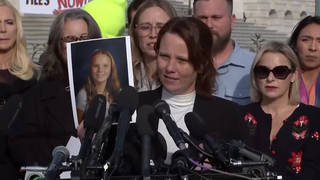
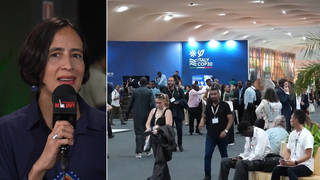
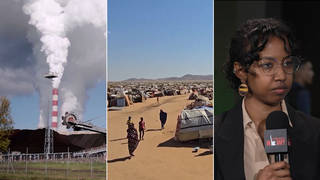






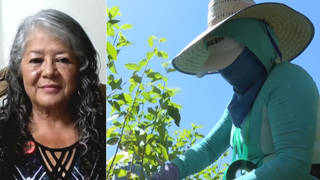
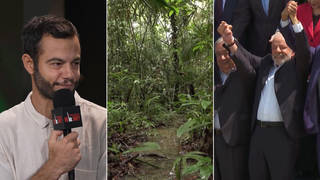
Media Options